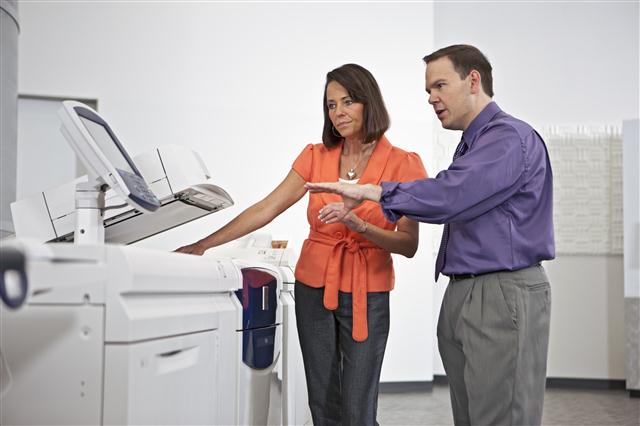Written by Howard Fenton, Senior Technology Consultant at NAPL
For most printing businesses, pricing is highly competitive because the manufacturing costs are similar for different companies. Generally speaking, different companies use the similar equipment, paper, and consumables and are in the same area with similar utility and building costs. Successful companies may have newer/faster equipment, better-trained staff, and more efficient procedures, but in general, the manufacturing costs and resulting pricing are typically within a defined range.
According to the latest NAPL/NAQP Financial Benchmarking Study (2010) of small printers, the cost of goods, payroll and overhead make up 90% of all costs. According to the PIA Ratios 2009-2010 for all printers, the total factory cost of the product was 78%.
One of the keys to ensuring lower printing costs is matching equipment capacity to production demand. If customer demand exceeds machine capacity, overtime or outsourcing may occur, which is more expensive. If capacity exceeds demand, then you may be paying too high a price for a piece of equipment that is sitting idle.
When a machine’s capacity matches the production demand it remains in use or has a high utilization rate. The utilization rate is a critical factor in determining which equipment is most appropriate because it determines the costs of manufacturing.
How do you determine how well a machine’s capacity matches customer demand? We feel that demand has to fit within a range to be considered appropriate. If the machine is only used 2 hours a day, it may be cheaper to buy that product. If the machine is busy 6 hours a day, then the costs should be very competitive. It does not matter if the printing technology is offset or digital – you never get 100% utilization.
With offset you have to change plates, refill ink / paper, and wash blankets while with digital you have to refill toner, replace belts, and vacuum. And both require scheduled and unscheduled maintenance. But leading companies can achieve 65-75% utilization rates across multiple shifts, with different types of jobs and using different printing equipment.
What is your utilization rate?
Howard Fenton is a Senior Technology Consultant at NAPL. Howie advises commercial printers, in-plants, and manufacturers on workflow management, operations, digital services, and customer research.
12 Comments
Comments are closed.



Something I see is printers confusing utilization rates and uptime–or equipment availability. They may use a device 6 hours a shift, but as long as it’s ready when they need it, they insist they have 90 or even 100 percent up time. That’s fine, but on has to wonder how and if they are calculating all the costs associated with the press. 6 hours of a shift equals a really nice 75% utilization, but the other two hours definitely have a cost attached.
About 6 years ago I saw some research that showed the average utilization of digital equipment was 8%. I can’t remember the source but I was looking at buying a Xerox 8000.
A Xerox 8000 prints 80 A4 100gsm per minute or 4800 per hour or theoretically 806,400 for a 168 hour month.
So 8% would be about 64,500 A4 prints per month.
At that time a 8000 needed a preventative maintenance call every 50,000 prints which would normally take 3-4 hours. Add in some breakdowns and the theoretical utilization rates start to fall.
At 75% utilization the 8000 would produce 600,000 A4 prints per month for a one-shift operation.
This may be possible in a mail-house but I believe it would be impossible in a print-for-pay business.
Nor would it be desirable. In my business, to achieve that sales volume, I would have to do more offset to digital transfer of longer run-lengths with a corresponding lower price per page.
ie Work harder for the same profit.
I have found that if I chase print volumes I tend to discount. So these days I try to concentrate on revenue and profit and let the print volumes and utilization rates look after themselves.
Utilization rates can be useful for determining costs but sale prices should be related to what the market will pay.
Hopefully more than it costs.
What is the utilization rate in most printing companies so we can determine if the machines are over utilize and if do we need to add machines or not. This is needed for our thesis.
Looking forward for your answer.
Thank you for your attention.
I have seen utilization rates from 5%-75%. Generally I find that if a machine is busy less then 2 hrs a day it is underutilized and the resulting cost per page is too high. I like to see a minimum 50% utilization after removing time for scheduled and unscheduled maintenance and paper loading and unloading.
I have just bought a digital printing business.What is the correct formula to use in calculating costs and profit margins.I stay in South Africa
Thanks
Gary
Gary,
It’s important to differentiate between running costs and total costs. Often times the numbers that you’re quoted when buying the equipment are running costs and they might not include equipment, staffing, consumables, maintenance, and overhead. But if you truly want to know your fully burdened cost per page you need to figure out your total cost so you can divide them across the total number of pages. I don’t know how competitive the pricing is in South Africa, I’ve never worked there.
Howie Fenton, NAPL